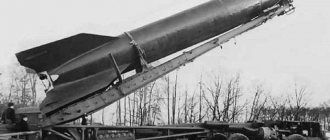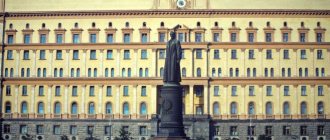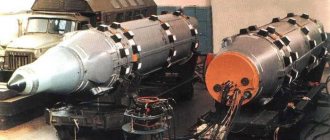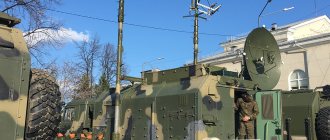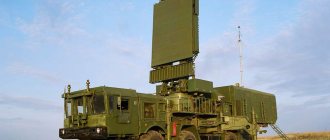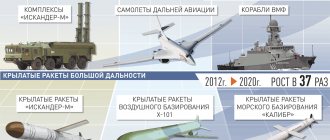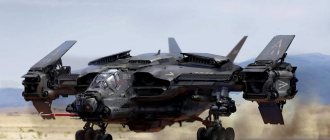This term has other meanings, see Pole.
| Pole | |
| Skif-DM , product 17F19DM | |
| Manufacturer | NPO Energia, KB Salyut |
| Orbital entry | not displayed |
| Launch | May 15, 1987 |
| Launch vehicle | Energy |
| Launch pad | Baikonur Sq. 250 |
| Specifications | |
| Weight | 77 t (without modules) |
| Dimensions | length: 37 m, diameter: 4.1 m |
"Pole"
(
Skif-DM
,
product 17F19DM
) - a spacecraft, a dynamic mock-up (DM) of the combat laser orbital platform
"Skif"
, payload used during the first launch of the Energia launch vehicle in 1987.
History of creation
Orbital platform "Skif"
"Scythian"
- a project for a combat laser orbital platform weighing over 80 tons, the development of which began in the late 1970s at NPO Energia (in 1981, due to the heavy workload of the association, the “Skif” theme was transferred to the Salyut design bureau). On August 18, 1983, General Secretary of the CPSU Central Committee Yuri Andropov made a statement that the USSR unilaterally stopped testing the anti-space defense complex, but in connection with the implementation of the SOI program in the United States, work on the Skif continued.
In particular, for the laser orbital platform, JSC Khimavtomatiki Design Bureau developed a gas-dynamic CO2 laser GDL RD0600[1] with a power of 100 kW and dimensions of 2140x1820x680 mm, which by 2011 had undergone a full cycle of bench testing.
Dynamic layout Skif-DM
As part of the Skif
In 1986-1987, an experimental launch into orbit of a size-and-weight model of the station (
Skif-DM
) was planned using the
Energia
.
Skif-DM
had a length of 37 meters, a maximum diameter of 4.1 meters and a mass of about 80 tons. It consisted of two main compartments: a smaller one - a functional and service unit and a larger one - a target module. The functional and service block was a long-developed supply spacecraft for the Salyut orbital station. The systems for controlling the motion and on-board complex, telemetric control, command radio communications, providing thermal conditions, power supply, separation and discharge of fairings, antenna devices, and a control system for scientific experiments were located here. All instruments and systems that could not withstand vacuum were located in a sealed instrument and cargo compartment. The propulsion system compartment housed 4 main engines, 20 orientation and stabilization engines and 16 precision stabilization engines, as well as tanks, pipelines and valves of the pneumatic hydraulic system servicing the engines. Solar panels were placed on the side surfaces of the propulsion system, opening after entering orbit.
Skif-DM flight program
included ten experiments: four applied and six geophysical.
Notes[ | ]
- ↑ 1 2 Andrey Borisov.
Russian gravedigger.
Russian killer satellites are ready to start a war in space (Russian). Weapons: Science and Technology
. Lenta.ru (April 23, 2018). Date accessed: June 22, 2022. Archived April 23, 2022. - GDL RD0600. Gas dynamic laser. (Russian). Scientific and technical complex - Prospective developments
. JSC Khimavtomatiki Design Bureau. Access date: June 22, 2022. Archived March 20, 2011. - Whose laser guns are more powerful - American ones or ours? (Russian). KP.ru (October 21, 2010). Access date: June 22, 2022. Archived October 23, 2010.
- Anton Pervushin.
Battle for the Stars: Cosmic Confrontation. — 2nd ed. - AST, 2004. - P. 604. - 831 p. — ISBN 5-17-024200-X.
Launch of the Energia-Skif-DM complex on May 15, 1987
Initially, the launch of the Energia-Skif-DM system was planned for September 1986. However, due to delays in the manufacture of the device, preparation of the launcher and other systems of the cosmodrome, the launch was postponed for almost six months - to May 15, 1987. Only at the end of January 1987, the device was transported from the installation and testing building at the 92nd site of the cosmodrome, where it was undergoing training, to the building of the installation and refueling complex. There, on February 3, 1987, Skif-DM was docked with the Energia launch vehicle. The next day, the complex was taken to the universal complex launch stand at site 250. In fact, the Energia-Skif-DM complex was ready for launch only at the end of April.
The launch of the complex took place on May 15, 1987 with a delay of five hours[2]. Two stages of “Energy” worked successfully. 460 seconds after launch, the Skif-DM separated from the launch vehicle at an altitude of 110 kilometers. The process of turning the spacecraft after separation from the launch vehicle took longer than expected due to a switching error in the electrical circuit. As a result, Skif-DM did not enter the intended orbit and fell into the Pacific Ocean along a ballistic trajectory. Despite this, according to the assessment indicated in the report, more than 80% of the planned experiments were completed.
Public message
On May 15, 1987, TASS published a message that, in particular, said:
| The Soviet Union has begun flight design tests of a new powerful universal launch vehicle “Energia”, designed to launch into low-Earth orbits both reusable orbital vehicles and large-sized spacecraft for scientific and national economic purposes. A two-stage universal launch vehicle... capable of launching more than 100 tons of payload into orbit... On May 15, 1987, at 21:30 Moscow time, the first launch of this rocket was carried out from the Baikonur Cosmodrome... The second stage of the launch vehicle... brought the overall weight model to the design point satellite The overall weight model, after separation from the second stage, was to be launched into a circular near-Earth orbit using its own engine. However, due to abnormal operation of its onboard systems, the model did not enter the intended orbit and splashed down in the Pacific Ocean... |
Purposes of creation[ | ]
"Skif DM"
was created to destroy enemy ICBMs and satellites [
source not specified 498 days
].
Also, along with the creation of combat space stations, Soviet scientists conducted a number of experiments.
The “VP1” experiment was devoted to testing a scheme for launching a large-sized spacecraft using a containerless scheme. In the “VP2” experiment, studies were carried out on the conditions for launching a large-sized apparatus, its structural elements and systems. The “VPZ” experiment was devoted to experimental testing of the principles of constructing a large-sized and super-heavy spacecraft (unified module, control systems, thermal control, power supply, electromagnetic compatibility issues). In the “VP11” experiment it was planned to test the flight scheme and technology. The Mirage geophysical experiment program was devoted to studying the influence of combustion products on the upper layers of the atmosphere and ionosphere. The Mirage1 (“A1”) experiment was to be carried out to an altitude of 120 kilometers during the launch phase; experiment “Mirage-2” (“A2”) - at altitudes from 120 to 280 kilometers during additional acceleration; experiment “Mirage-3” (“A3”) - at altitudes from 280 to the Earth during braking. Geophysical experiments “GF-1/1”, “GF-1/2” and “GF-1/3” were planned to be carried out while the propulsion system of the Skif-DM apparatus was operating. The “GF-1/1” experiment was dedicated to the generation of artificial internal gravitational waves [ clarify
] upper atmosphere.
The goal of the GF-1/2 experiment was to create an artificial “dynamo effect” in the earth’s ionosphere. Finally, the “GF-1/3” experiment was planned to create large-scale ion formations in ion- and plasmaspheres (holes and ducts) [ clarify
]. For this, the Polyus was equipped with a large amount (420 kilograms) of a gas mixture of xenon and krypton (42 cylinders, each with a capacity of 36 liters) and a system for releasing it into the ionosphere.
After the experiments, all the necessary material was obtained to clarify the loads on the Buran orbital ship to ensure its flight tests. During the launch and autonomous flight of the device, all four applied experiments were performed (“VP-1”, “VP-2”, “VP-3” and “VP-11”), as well as part of the geophysical experiments (“Mirage-1” and partially “GF-1/1” and “GF-1/3”).
The conclusion following the launch stated:
“...Thus, the general tasks of launching the product, determined by the launch tasks approved by MOM and UNKS, taking into account the “Decision” of May 13, 1987 to limit the volume of target experiments, were completed by more than 80% in terms of the number of tasks solved.”[4]
Links
- www.buran.ru/htm/cargo.htm
- www.astronautix.com/craft/polyus.htm
- www.buran.ru/htm/scr.htm -screensaver with a space station and other spacecraft.
ZEUS-HLONS Boeing YAL-1 Space "Pole" Stationary "Terra" Laser Weapon System (LaWS) • Nautilus (THEL) Future PRC: Chinese Modular Space Station •
USA:
Bigelow Commercial Space Station •
Russia:
National Orbital Space StationCompleted THE USSR: Salyut ( • ¹ ² • Cosmos-557¹ • ² • • ² • • ) • Almaz (Cosmos-1870¹ • Almaz-1A¹ •)
USSR / Russia:
Mir •
USA:
Skylab • Spacehab •
Europe:
SpacelabPart of the ISS Columbus (Europe) • World-2 (USSR / Russia) • Freedom (USA) Canceled USA: Manned Orbital Laboratory (MOL) • Skylab B •
USSR: Polyus¹ • Russia:
Commercial Space Station • Almaz-1B¹ •
PRC:
Tiangong-3•
Bigelow Aerospace
: Galaxy¹ Not used for human space travel. ² Part of the Almaz program for military purposes.
An excerpt characterizing the Pole (spacecraft)
Two hours later the carts stood in the courtyard of Bogucharov’s house. The men were briskly carrying out and placing the master's things on the carts, and Dron, at the request of Princess Marya, was released from the locker where he had been locked, standing in the courtyard, giving orders to the men. “Don’t put it in such a bad way,” said one of the men, a tall man with a round smiling face, taking the box from the maid’s hands. - It also costs money. Why do you throw it like that or half a rope - and it will rub. I don't like it that way. And so that everything is fair, according to the law. Just like that, under the matting and covering it with hay, that’s what’s important. Love! “Look for books, books,” said another man, who was taking out Prince Andrei’s library cabinets. - Don't cling! It's heavy, guys, the books are great! - Yes, they wrote, they didn’t walk! – the tall, round-faced man said with a significant wink, pointing to the thick lexicons lying on top. Rostov, not wanting to impose his acquaintance on the princess, did not go to her, but remained in the village, waiting for her to leave. Having waited for Princess Marya's carriages to leave the house, Rostov sat on horseback and accompanied her on horseback to the path occupied by our troops, twelve miles from Bogucharov. In Yankov, at the inn, he said goodbye to her respectfully, allowing himself to kiss her hand for the first time. “Aren’t you ashamed,” he answered Princess Marya, blushing, to the expression of gratitude for her salvation (as she called his action), “every police officer would have done the same.” If only we had to fight with the peasants, we would not have allowed the enemy so far away,” he said, ashamed of something and trying to change the conversation. “I’m only happy that I had the opportunity to meet you.” Farewell, princess, I wish you happiness and consolation and wish to meet you under happier conditions. If you don't want to make me blush, please don't thank me. But the princess, if she did not thank him in more words, thanked him with the whole expression of her face, beaming with gratitude and tenderness. She couldn't believe him, that she had nothing to thank him for. On the contrary, what was certain for her was that if he had not existed, she would probably have died from both the rebels and the French; that, in order to save her, he exposed himself to the most obvious and terrible dangers; and what was even more certain was that he was a man with a high and noble soul, who knew how to understand her situation and grief. His kind and honest eyes with tears appearing on them, while she herself, crying, talked to him about her loss, did not leave her imagination. When she said goodbye to him and was left alone, Princess Marya suddenly felt tears in her eyes, and here, not for the first time, she was presented with a strange question: does she love him? On the way further to Moscow, despite the fact that the princess’s situation was not happy, Dunyasha, who was riding with her in the carriage, more than once noticed that the princess, leaning out of the carriage window, was smiling joyfully and sadly at something. “Well, what if I loved him? - thought Princess Marya. Ashamed as she was to admit to herself that she was the first to love a man who, perhaps, would never love her, she consoled herself with the thought that no one would ever know this and that it would not be her fault if she remained without anyone for the rest of her life. speaking of loving the one she loved for the first and last time. Sometimes she remembered his views, his participation, his words, and it seemed to her that happiness was not impossible. And then Dunyasha noticed that she was smiling and looking out the carriage window. “And he had to come to Bogucharovo, and at that very moment! - thought Princess Marya. “And his sister should have refused Prince Andrei!” “And in all this, Princess Marya saw the will of Providence. The impression made on Rostov by Princess Marya was very pleasant. When he remembered about her, he became cheerful, and when his comrades, having learned about his adventure in Bogucharovo, joked to him that, having gone for hay, he picked up one of the richest brides in Russia, Rostov became angry. He was angry precisely because the thought of marrying the meek Princess Marya, who was pleasant to him and with a huge fortune, came into his head more than once against his will. For himself personally, Nikolai could not wish for a better wife than Princess Marya: marrying her would make the countess - his mother - happy, and would improve his father’s affairs; and even - Nikolai felt it - would have made Princess Marya happy. But Sonya? And this word? And this is why Rostov got angry when they joked about Princess Bolkonskaya. Having taken command of the armies, Kutuzov remembered Prince Andrei and sent him an order to come to the main apartment. Prince Andrei arrived in Tsarevo Zaimishche on the very day and at the very time of the day when Kutuzov made the first review of the troops. Prince Andrei stopped in the village at the priest’s house, where the commander-in-chief’s carriage stood, and sat on a bench at the gate, waiting for His Serene Highness, as everyone now called Kutuzov. On the field outside the village one could hear either the sounds of regimental music or the roar of a huge number of voices shouting “hurray!” to the new commander-in-chief. Right there at the gate, ten steps from Prince Andrei, taking advantage of the prince’s absence and the beautiful weather, stood two orderlies, a courier and a butler. Blackish, overgrown with mustaches and sideburns, the little hussar lieutenant colonel rode up to the gate and, looking at Prince Andrei, asked: is His Serene Highness standing here and will he be there soon? Prince Andrei said that he did not belong to the headquarters of His Serene Highness and was also a visitor. The hussar lieutenant colonel turned to the smart orderly, and the orderly of the commander-in-chief said to him with that special contempt with which the orderlies of commanders-in-chief speak to officers: “What, your Serene Highness?” It must be now. You that? The hussar lieutenant colonel grinned into his mustache in the tone of the orderly, got off his horse, gave it to the messenger and approached Bolkonsky, bowing slightly to him. Bolkonsky stood aside on the bench. The hussar lieutenant colonel sat down next to him. – Are you also waiting for the commander-in-chief? - the hussar lieutenant colonel spoke. – Govog’yat, it’s accessible to everyone, thank God. There’s a problem with sausage makers! Nedag Egmolov joined the Germans. Now, maybe it will be possible to talk in G'ussian. Otherwise they don't know what they were doing. Everyone retreated, everyone retreated. Have you done the hike? - he asked. “I had the pleasure,” answered Prince Andrei, “not only to participate in the retreat, but also to lose in this retreat everything that was dear to me, not to mention the estates and home... of my father, who died of grief.” I am from Smolensk. - Eh?.. Are you Prince Bolkonsky? It would be great to meet you: Lieutenant Colonel Denisov, better known as Vaska,” said Denisov, shaking Prince Andrei’s hand and peering into Bolkonsky’s face with especially kind attention. “Yes, I heard,” he said with sympathy and, after a short silence, continued: “Here comes the Scythian war.” This is all hog'osho, but not for those who take the rap on their own sides. Are you Prince Andgey Bolkonsky? – He shook his head. “It’s very nice, prince, it’s very nice to meet you,” he added again with a sad smile, shaking his hand. Prince Andrei knew Denisov from Natasha's stories about her first groom. This memory, both sweet and painful, now transported him to those painful sensations that he had not thought about for a long time, but which were still in his soul. Recently, so many other and such serious impressions as leaving Smolensk, his arrival in Bald Mountains, the recent death of his father - so many sensations were experienced by him that these memories had not come to him for a long time and, when they did, had no effect on him. him with the same strength. And for Denisov, the series of memories that Bolkonsky’s name evoked was a distant, poetic past, when, after dinner and Natasha’s singing, he, without knowing how, proposed to a fifteen-year-old girl. He smiled at the memories of that time and his love for Natasha and immediately moved on to what was now passionately and exclusively occupying him. This was the campaign plan he came up with while serving in the outposts during the retreat. He presented this plan to Barclay de Tolly and now intended to present it to Kutuzov. The plan was based on the fact that the French line of operations was too extended and that instead of, or at the same time, acting from the front, blocking the way for the French, it was necessary to act on their messages. He began to explain his plan to Prince Andrei.


